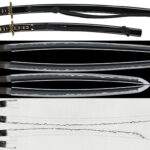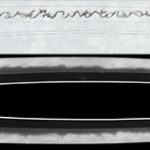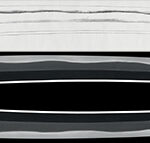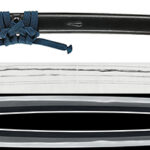Ordering number:23893
Wakizashi: Shirasaya with Koshirae (NBTHK Hozon Token)(NBTHK Tokubetsu Kicho Token)
Signature: Omi Daijo Fujiwara Tadahiro
近江大掾藤原忠広
We divide 4 sections for each sword as Saijyo Saku, Jyojyo Saku, Jyo Saku, and Regular Saku.
This piece is classified as a "Jyojyo Saku" work by Omi Daijo Fujiwara Tadahiro.
Habaki: Single copper
Blade Length: 1 shaku 7 sun 6 bu (53.33 cm / 21 in)
Curvature: 3 bu (0.91 cm / 0.36 in)
Mekugi Hole(s): 2
Width at Base (Motohaba): 2.82 cm (1.11 in)
Width at Tip (Sakihaba): 2.14 cm (0.84 in)
Thickness: 0.66 cm (0.26 in)
Sword Weight: 515 grams (1.14 lb)
Era: Around the Kanbun era of the Edo period
Shape: The blade is relatively wide with a thick kasane (rim thickness), moderate curvature, and a slightly extended tip.
Jigane: The jigane shows a well-forged small itame pattern, displaying a beautiful ko-nuka hada or Hizen hada.
Hamon: The hamon is a suguha with a deep nioiguchi, showing frequent ko-ashi activity. The boshi is rounded with deep nioiguchi activity.
Features: Omi Daijo Tadahiro lost his father in the Kanei era and inherited the title of the second-generation smith at a young age. He was surrounded by many disciples and produced excellent works from the beginning. As the initial tension of the Kanei era eased, he created numerous pieces with proficient technique in the Kanbun era. This piece dates to the late Kanei period when the characters for "Omi Daijo" became slightly rounded, indicating an excellently crafted piece from this era.
Koshirae:
Tsuba: Iron tsuba in a circular shape, with high-relief carvings of chrysanthemums on both sides.
Signature: Made by Nagato's tsuba artisan Tomomitsu of Hagi, Choshu province.
Note: Tomomitsu, also known as Nakai Zenbei, was an Edo-period tsuba craftsman known for his precise work and solid iron quality.
Fuchikashira: Made of shakudo with nanako ground, decorated with flowers and insects in gold.
Saya (Scabbard): Lacquered in glossy black roiro finish.
Kozuka: Made of shibuichi, depicting a turtle and a fish basket (biku). While the design appears simple, the details of the turtle and basket are finely crafted.
Menuki: Made of shakudo, with high-relief chrysanthemums and colored with gold accents.
Aoi Art’s Comment: This piece dates back to the Kanei era and is well-made, reflecting the craftsmanship of the period.
Historical Background:
During the Kanei era of the Edo period, the practice of entering castles with a daisho (paired long and short swords) became customary, marking the formalization of Edo-period etiquette. Furthermore, affluent townspeople were permitted to carry wakizashi, leading the wealthy to own more luxurious items.
NBTHK Hozon Token
NBTHK Tokubetsu Kicho Token
AoiArt Estimation Paper
Whole Oshigata
Price:550,000JPY
Order Form
Related Items:
 Wakizashi: Omi Daijo Fujiwara Tadahiro(NBTHK Tokubetsu Hozon Token)
Wakizashi: Omi Daijo Fujiwara Tadahiro(NBTHK Tokubetsu Hozon Token)
 Dai Sho : Motohira(Dai Sho:NBTHK Tokubetsu Hozon Token)(Daisho Koshirae: NBTHK Tokubetsu Hozon Tosogu)
Dai Sho : Motohira(Dai Sho:NBTHK Tokubetsu Hozon Token)(Daisho Koshirae: NBTHK Tokubetsu Hozon Tosogu)
 Wakizashi: Omi Daijo Fujiwara Tadahiro(NBTHK Tokubetsu Hozon Token)
Wakizashi: Omi Daijo Fujiwara Tadahiro(NBTHK Tokubetsu Hozon Token)
 Wakizashi: Omi Daijo Fujiwara Tadayoshi (4th Generation)(NBTHK Tokubetsu Hozon Token)
Wakizashi: Omi Daijo Fujiwara Tadayoshi (4th Generation)(NBTHK Tokubetsu Hozon Token)
 Wakizashi:Soshu Ju Ise Daijo Fujiwara Tsunahiro(Hozon Token, Tokubetsu Kicho Token)
Wakizashi:Soshu Ju Ise Daijo Fujiwara Tsunahiro(Hozon Token, Tokubetsu Kicho Token)
 Wakizashi:Oumi Daijo Fujiwara Tadahiro(Tokubetsu Hozon Token)
Wakizashi:Oumi Daijo Fujiwara Tadahiro(Tokubetsu Hozon Token)







